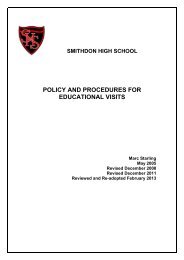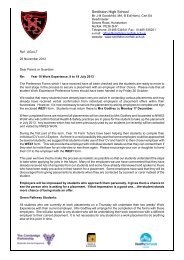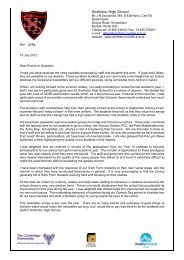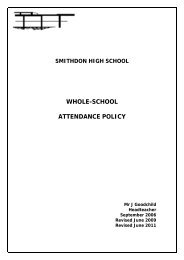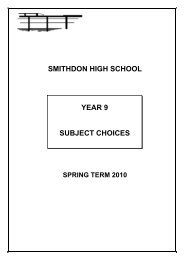SMITHDON HIGH SCHOOL ANTI-BULLYING POLICY
SMITHDON HIGH SCHOOL ANTI-BULLYING POLICY
SMITHDON HIGH SCHOOL ANTI-BULLYING POLICY
You also want an ePaper? Increase the reach of your titles
YUMPU automatically turns print PDFs into web optimized ePapers that Google loves.
<strong>SMITHDON</strong> <strong>HIGH</strong> <strong>SCHOOL</strong><br />
<strong>ANTI</strong>-<strong>BULLYING</strong> <strong>POLICY</strong><br />
Mr M Grimes<br />
Deputy Headteacher<br />
July 1997<br />
Revised – February 2008<br />
/June 2011
1. Aims<br />
1.1 To clarify to students, parents and staff that bullying is unacceptable, that<br />
every student has the right to feel safe in school and to be protected<br />
when he/she is feeling vulnerable.<br />
2. What is Bullying?<br />
2.1 A person is being bullied when he or she is exposed to negative actions<br />
on the part of one or more persons. These actions can be either a single<br />
incident or a series of persistent issues and will result in the victim feeling<br />
hurt, threatened or frightened. Bullying can be physical or verbal and<br />
include hitting, teasing, intimidation, damaging a person's property as well<br />
as racial, sexual and disability harassment.<br />
2.2 Bullying can also involve cyberbullying. This can be defined as the use of<br />
Information and Communications Technology (ICT), particularly mobile<br />
phones and the internet, deliberately to upset someone else – as in 2.1.<br />
This may include the use of text messages or of personal or private<br />
information or images which may be sent to the victim or publicly posted<br />
or forwarded.<br />
2.2 It is important to note that the perceptions of the individual in this are<br />
crucial and that the feeling of being bullied is personal.<br />
2.3 This policy applies to all students and staff working at the school.<br />
3. Encouraging Students to Tell<br />
3.1 It is vital that we foster a supportive structure within our school<br />
community. Students need to feel that they can tell someone if they feel<br />
vulnerable, that they will be listened to sympathetically and that action<br />
will be taken. Teachers, parents and other students have a key role to<br />
play here. Not telling protects the bully or bullies and gives out the<br />
message that they can continue. They may bully other students too.<br />
3.2 Students should remember to let us know straight away if they are being<br />
bullied or if someone else is.<br />
3.3 Parents, if you think that your son or daughter is being bullied, let us<br />
know immediately.<br />
4. Possible Signs<br />
4.1 A student who is being bullied may exhibit changes in behaviour, such as<br />
feigning illness or becoming shy and nervous. They may show changes in<br />
attitude towards work, may lack concentration or may even truant from<br />
school.
5. Procedures<br />
5.1 Whenever a student indicates that they are unhappy about the way they<br />
are being treated by others they must be taken seriously and should be<br />
encouraged to write down their experience. The disclosure should then be<br />
passed direct to the Head of Year of that student. The Head of Year will<br />
then interview the student to discuss their concerns. If, by this stage there<br />
is no written account, one should be made.<br />
5.2 The victim of bullying will then be encouraged to tell the bully or bullies, in<br />
the presence of the Head of Year, what they are unhappy about. This<br />
should be done in a non-aggressive way and involves discussing this with<br />
the bullied student beforehand. This enables the victim to assert<br />
themselves and fosters the development of self-confidence. If there are<br />
several other students involved, they should be seen separately to alleviate<br />
possible anxiety in the victim. If this is not the wish of the student<br />
concerned, then the issues will be dealt with by the member of staff and<br />
those responsible.<br />
5.3 The approach adopted is one of restorative justice, which is nonconfrontational<br />
and involves the teacher helping the bully to understand<br />
more about how the victim is feeling and seeking a commitment that they<br />
will try to help the victim in some way.<br />
5.4 A record should be made of the outcome of the interviews, with the bully<br />
(or bullies) recording their responses in writing. The parents of all students<br />
involved will be informed of what has happened and the action that has<br />
been taken. Copies of the procedure will be circulated to the Form Tutors<br />
of all pupils concerned and copies placed in the students' files.<br />
5.5 The Head of Year should arrange to see the bullied student during the<br />
following week and perhaps at intervals thereafter to check on progress.<br />
Monitoring can also take place on a regular basis through the Form Tutor.<br />
The length of monitoring will depend upon the nature of the concerns and<br />
will be at the professional discretion of the Year Head.<br />
5.6 In the event that the bullying recurs and it is clear that the original<br />
intervention has not worked, then sanctions will follow. These will depend<br />
upon the nature of the bullying behaviour and may involve the Assistant<br />
Headteacher and, in very serious cases, the Headteacher. It is important<br />
that counselling of both parties continues even when sanctions have been<br />
imposed.<br />
5.7 It should be noted that under the 2006 Education and Inspections Act,<br />
schools have the power to respond to the behaviour of students when they<br />
are off school premises. Where a student is involved in the bullying or<br />
harassment of another student or member of staff, including when such<br />
behaviour occurs out of school, the school has a right to intervene and to<br />
impose appropriate sanctions.<br />
5.8 Where it is suspected that a criminal offence may have been committed,<br />
the police will be informed.
5.9 Although bullying is not a specific criminal offence in UK law, there are laws<br />
that can apply in terms of harassment or threatening behaviour. In<br />
particular, some cyberbullying activities could be criminal offences under<br />
the Protection from Harassment Act 1997, The Malicious Communications<br />
Act 2003 and the Public Order Act 1986.<br />
The age of criminal responsibility in the UK is 10.<br />
6. Curriculum<br />
6.1 The issue of bullying, including cyberbullying, will be dealt with during Citizenship<br />
sessions and can be supported in other curriculum areas and by using teaching<br />
methods which encourage co-operative work with a variety of groupings so that<br />
students can extend their relationships beyond their normal friendship groups.<br />
7. Review<br />
7.1 This policy will be reviewed annually.




